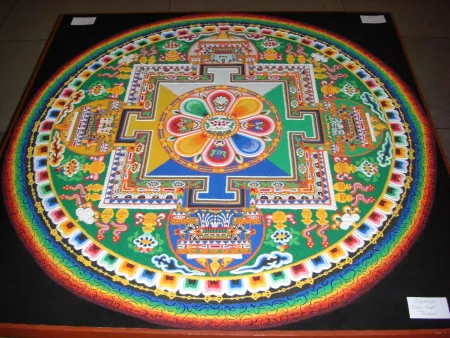The Tibetan word for mandala is kilkhor, which means "center of the circle with exterior walls and surrounding environment." A mandala is a visual prayer and it is also a symbolic universe. It may be represented by a three-dimensional model or more often two-dimensionally by means of a painted scroll, called a thangka.
Mandalas may also be created with precious jewels, flowers, dyed rice, colored stones, or colored sand on a two-dimensional surface. Colored sand is considered the most efficacious material because of the great skill required to create the mandala's exquisite details.
It is believed that each grain of sand is charged with the blessings of the ritual process, and thus, it is felt that each of the million or more grains of sand laid down in a painting is charged with powerful blessing. Much spiritual energy is believed to be invoked while constructing the sand mandala.
According to Tibetan Buddhist belief, the purpose, meanings, and techniques involved in the art of sand mandala construction were taught by Shakyamuni, the historical Buddha, in the fifth or sixth century B.C.E. in India. Tibetan Buddhists maintain that this tradition has been preserved over the past 2,500 years in an unbroken transmission from master to disciple.
Each mandala is a sacred mansion, the home of a particular deity, who symbolically represents and embodies enlightened qualities, such as compassion. In the Tibetan Buddhist tradition, mandalas are created for rituals of initiation in which a highly qualified teacher grants permission to advanced disciples to engage in the meditation practice of a particular tantric deity. Both the deity, which resides at the center of the mandala, and the mandala itself are recognized as pure expressions of a Buddha's fully enlightened mind.
Tibetan Buddhists believe that the seed of enlightenment in each person's mind can be nourished by the dynamic process of visualizing and contemplating the symbolic meanings contained within a mandala. Through this kind of tantric practice, the initiate attempts to identify with and integrate these positive spiritual qualities into himself or herself in this path to enlightenment so as to be of greater benefit to all sentient beings.
For the Tibetan Buddhist, the mandala displays the architecture of exaltation, the inspiring three-dimensional realm of Buddhahood, built in a purified imagination. This realm is achieved through a heightened state of clarity and stability of visualization combined with deep insight and a radical internal transformation of the mind.
The physical mandala is constructed as an aid to this visualization practice, which acts as a blueprint for the imagination. On rare occasions, a two-dimensional mandala is created on a flat surface with powdered particles of brilliant color - the sand mandala.
In Tibetan folklore, it is thought a great blessing just to see a well-made mandala, since the impression goes deep into the subconscious.
